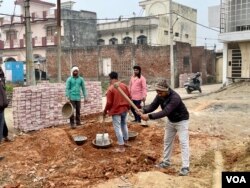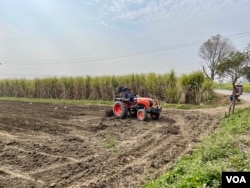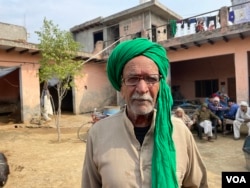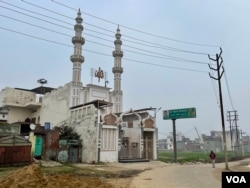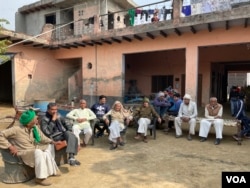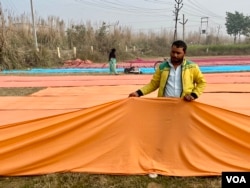In the narrow lanes and courtyards of village homes in a lush sugarcane growing belt in India’s Uttar Pradesh state, there are animated debates over which party should govern the country’s most populous state.
The state starts polling Thursday – it will be the first among five states that choose new local governments this month.
The outcome in Uttar Pradesh, a national political bellwether, will be a midterm verdict on Prime Minister Narendra Modi’s Hindu nationalist Bharatiya Janata Party.
“Earlier, the roads in our villages were filled with potholes. Now they are much better,” said Bablu Tyagi, a young farmer from Didoli village, who wants the BJP to return to power. “The cost of living has gone up, but that happens with every government.”
In a town close by, many don’t share that sentiment. “There has been no development in Muradnagar. Everyone’s business is hit, children’s education is suffering, and young people are struggling to get jobs,” said Haji Shafiq, a supplier of building material in a nearby town.
Five years ago, in the primarily rural region, village communities had helped the BJP trounce the regional Samajwadi Party and catapulted it to power on promises of development, jobs and better incomes for farmers.
Getting re-elected to a second term is important for the BJP, according to political analysts. “It’s a do or die battle for the party because Uttar Pradesh accounts for so many members of parliament. Also, in the last four or five years, the BJP has lost several state elections, especially where they were ruling, so a victory here is critical,” said Sanjay Kumar, director of the Center for Study of Developing Societies in New Delhi.
But the party is battling discontent in one of the country’s economically marginalized states, home to more than 200 million.
In many villages, the impact of a year-long farmers protest held last year is still resonating. Many farmers in Uttar Pradesh had supported a movement to repeal the laws, and although in a rare concession, Prime Minister Modi scrapped the laws but the anger has not abated.
“Just taking back the laws did not solve our problem,” said Raj Singh, a 99-year-old farmer from Jalalabad village who joined the protest. “We don’t get good prices for our crops. We don’t get paid in time. Farmers and farm laborers are devastated.”
The discontent of the village elder is echoed by older and younger farmers sitting in his home. The lack of jobs has made it difficult for many to move out of agriculture, but high inflation has hurt their farming incomes, they say.
“Whether you take seeds or fertilizers, or electricity, costs have shot up, but our incomes have not kept pace with expenses. From that point of view farmers are losers,” said Achin, a farmer.
Despite the growing anger among farmers, the BJP is expected to return to power, although with a slimmer majority in a state with complex caste and religious politics.
Political analysts say the issue of religion will influence the poll outcome in the state, which is headed by a Hindu priest, Yogi Adityanath, who critics call a hardliner. The BJP is showcasing the ongoing construction of a grand temple at Ayodhya town in the state to honor Hindu God Rama at a site where a mosque once stood. The land was handed over to Hindus after a prolonged court battle in 2019.
“The question of religious identity is going to play a very important role. The point being emphasized is that Hindus must have a place they deserve in this country, and the BJP is instrumental in building the temple,” Kumar said.
In campaign speeches last month, Adityanath, characterized the ballot as “80% versus 20%,” figures he did not elaborate on. But analysts say it is a reference to the majority Hindu and minority Muslim community in the state.
Many Muslims, who make up nearly 20% of the population in the state, complain of religious polarization. “The BJP government has created a divide between Hindus and Muslims. We had always lived like brothers,” says Haji Shafiq, a supplier of building material in Muradnagar town.
The BJP says it does not discriminate against any community and its economic and social policies benefit all equally. It is campaigning on a plank of good governance, saying that in a state that had a high crime rate, it has restored law and order.
Some agree. “I can put my cattle out to graze until night without worrying,” says Aslam Kasar, a daily wage worker, who keeps some buffalo. “Earlier, people would steal them, and the police would not help us.”
Political analysts say the BJP is hoping to pick up votes on the issue. “There is a lot of emphasis on law and order. They are associating crime with the Samajwadi Party while making oblique references to people they hint are responsible for deteriorating law and order, the Muslims, etc.,” Kumar said.
The polls in Uttar Pradesh will be conducted in seven phases concluding on March 7 and results will be announced on March 10.
Which way the vote goes will be crucial for Modi ahead of national elections that will take place after two years. He had won a resounding victory in 2019.
“A win in Uttar Pradesh is imperative because otherwise, the narrative will start building that the BJP can be defeated in 2024 and this will give momentum to opposition parties,” Kumar said.






